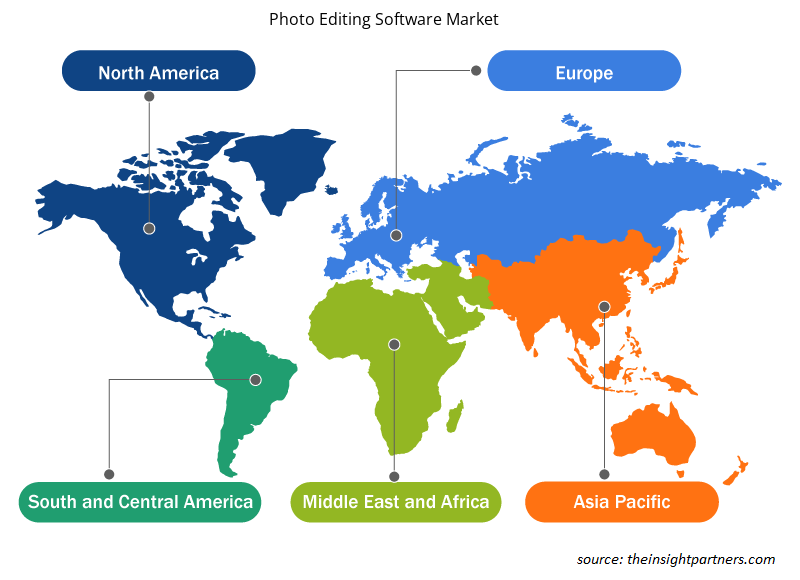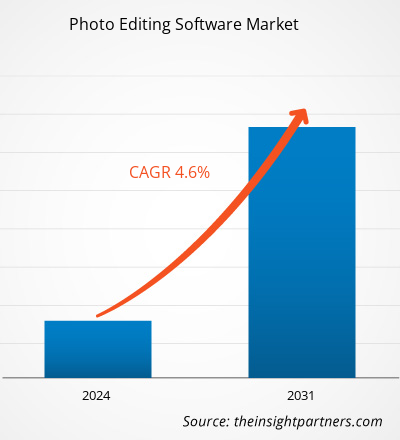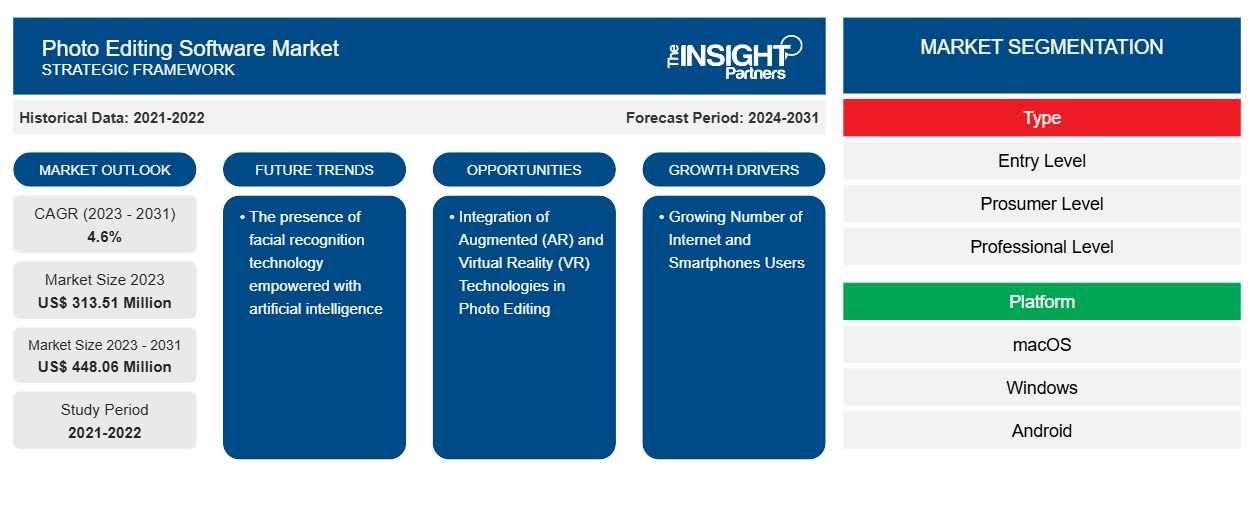사진 편집 소프트웨어 시장 규모는 2023년 3억 1,351만 달러에서 2031년 4억 4,806만 달러로 성장할 것으로 예상됩니다. 이 시장은 2023~2031년에 4.6%의 CAGR을 기록할 것으로 예상됩니다 . 인공 지능을 탑재한 얼굴 인식 기술의 존재는 사진 편집 소프트웨어 시장의 주요 트렌드로 남을 가능성이 높습니다.
사진 편집 소프트웨어 시장 분석
사진 편집 소프트웨어 시장은 인터넷과 스마트폰 사용자의 증가와 소비자들 사이에서 디지털 사진에 대한 수요 증가로 인해 빠른 속도로 성장하고 있습니다. 시장은 개인 및 상업적 용도에서 고화질 이미지에 대한 수요가 증가함에 따라 꾸준히 확대되고 있습니다. 게다가, 사진 편집에서 증강현실(AR)과 가상현실( VR ) 기술을 통합하고 사진 편집 소프트웨어에서 계산 알고리즘을 사용하는 것이 증가함에 따라 시장 성장에 수익성 있는 기회가 제공되고 있습니다.
사진 편집 소프트웨어 시장 개요
사진 편집 소프트웨어는 사용자가 요구 사항에 따라 사진을 자르고, 복구하고, 정리할 수 있는 디지털 사진 애플리케이션입니다. 이 소프트웨어는 오래된 필름 사진을 스캔하여 디지털 이미지로 변환할 수 있습니다. 이러한 이미지는 결함을 제거하고 이미지 품질을 개선하여 디지털로 더욱 복원됩니다. 색상, 색조, 이미지 방향, 디지털 사진 , 계층 편집 등을 포함한 사진의 특수 효과에 대한 수요가 예측 기간 내내 시장을 활성화하고 있습니다.
귀하의 요구 사항에 맞게 이 보고서를 사용자 정의하세요
이 보고서의 일부 또는 국가 수준 분석, Excel 데이터 팩을 포함하여 모든 보고서에 대한 사용자 정의를 무료로 받을 수 있으며 신생 기업 및 대학을 위한 훌륭한 혜택과 할인 혜택을 이용할 수 있습니다.
-
이 보고서의 주요 시장 동향을 알아보세요.이 무료 샘플에는 시장 동향부터 추정 및 예측까지 다양한 데이터 분석이 포함됩니다.
사진 편집 소프트웨어 시장 동인 및 기회
인터넷과 스마트폰 사용자 증가로 시장이 성장하고 있습니다.
인터넷의 증가로 전 세계 소비자들 사이에서 스마트폰에 대한 수요가 증가하면서 시장을 주도하고 있습니다. 인터넷과 스마트폰은 시장을 주도하는 두 가지 주요 요인입니다. 스마트폰 사용자 수의 증가는 소셜 미디어의 영향과 관련이 있으며, 소비자들 사이에서 사진 편집 소프트웨어에 대한 수요를 급증시킵니다. 게다가 스마트폰의 인기 상승으로 인해 시장 공급업체들은 스마트폰에 맞게 특별히 설계된 사진 편집 소프트웨어를 개발하게 되었습니다. 스마트폰 제조업체들은 또한 이미지 편집 기능을 기본 카메라 앱에 직접 통합하여 사용자가 실시간으로 사진의 빛 균형과 노출 효과를 검사, 변경 및 관리할 수 있도록 하고 있습니다. 스마트폰의 카메라 성능과 처리 능력이 향상되면서 제조업체들은 뛰어난 모바일 사진 편집 애플리케이션을 생산하게 되었고, 이는 업계를 활성화시켰습니다.
사진 편집에서 증강현실(AR) 및 가상현실( VR ) 기술의 통합 - 사진 편집 소프트웨어 시장의 기회
사진 편집에 증강 현실과 가상 현실 기술을 통합하면 사용자는 획득한 이미지에 더욱 사실적인 효과를 적용하여 더욱 매력적으로 만들 수 있습니다. 또한 AR 및 VR 기술을 사용하면 이미지의 품질을 향상시켜 정확하고 사실적인 이미지를 제공하여 소비자의 수요가 증가하고 시장에서 기회가 창출됩니다. 또한 사진 편집에 AR 기술을 사용하면 최종 사용자가 정확하고 사실적인 이미지를 제공하는 동시에 사실적인 효과를 추가할 수 있습니다. 또한 스마트폰 카메라에 더욱 성공적인 깊이 센서가 등장하면서 증강 현실을 사진 편집 프로세스에 통합하기가 간편해졌습니다. 따라서 사진 편집 소프트웨어에 AR 및 VR 기술을 통합하는 것이 증가함에 따라 시장에 상당한 성장 기회가 창출되고 있습니다.
사진 편집 소프트웨어 시장 보고서 세분화 분석
사진 편집 소프트웨어 시장 분석에 기여한 주요 세그먼트는 유형, 플랫폼, 최종 사용자입니다.
- 사진 편집 소프트웨어 시장은 유형에 따라 엔트리 레벨, 프로슈머 레벨, 프로페셔널 레벨로 나뉩니다. 프로슈머 레벨 세그먼트는 2023년에 더 큰 시장 점유율을 차지했습니다.
- 플랫폼 기준으로 사진 편집 소프트웨어 시장은 macOS, 윈도우, 안드로이드, iOS로 나뉩니다. 윈도우 세그먼트는 2023년에 더 큰 시장 점유율을 차지했습니다.
- 최종 사용자 측면에서 시장은 개인 및 상업으로 분류됩니다. 상업 부문은 2023년에 더 큰 시장 점유율을 차지했습니다.
지역별 사진 편집 소프트웨어 시장 점유율 분석
사진 편집 소프트웨어 시장 보고서의 지리적 범위는 주로 북미, 아시아 태평양, 유럽, 중동 및 아프리카, 남미/남중미의 5개 지역으로 나뉩니다.
수익 측면에서 북미는 가장 큰 사진 편집 소프트웨어 시장 점유율을 차지했습니다. 소셜 미디어 광고의 도입, 유명 패션 브랜드의 존재, 온라인 광고 부문의 부상, 전자 상거래 산업의 확장, 중소기업의 성장은 지역 시장 성장에 기여한 중요한 요인입니다. 미국과 캐나다에서 인터넷, 현대 컴퓨터, 스마트폰의 높은 보급률은 비디오 스트리밍 산업의 성장에 유리한 분위기를 조성했으며, 이는 이 지역의 시장을 활성화할 것으로 예상됩니다.
사진 편집 소프트웨어 시장 지역 통찰력
Insight Partners의 분석가들은 예측 기간 동안 사진 편집 소프트웨어 시장에 영향을 미치는 지역적 추세와 요인을 철저히 설명했습니다. 이 섹션에서는 북미, 유럽, 아시아 태평양, 중동 및 아프리카, 남미 및 중미의 사진 편집 소프트웨어 시장 세그먼트와 지리에 대해서도 설명합니다.

- 사진 편집 소프트웨어 시장을 위한 지역별 데이터 얻기
사진 편집 소프트웨어 시장 보고서 범위
| 보고서 속성 | 세부 |
|---|---|
| 2023년 시장 규모 | 3억 1,351만 달러 |
| 2031년까지 시장 규모 | 4억 4,806만 달러 |
| 글로벌 CAGR (2023-2031) | 4.6% |
| 역사적 데이터 | 2021-2022 |
| 예측 기간 | 2024-2031 |
| 다루는 세그먼트 |
유형별로
|
| 포함된 지역 및 국가 |
북아메리카
|
| 시장 선도 기업 및 주요 회사 프로필 |
|
사진 편집 소프트웨어 시장 참여자 밀도: 비즈니스 역학에 미치는 영향 이해
사진 편집 소프트웨어 시장은 소비자 선호도의 변화, 기술 발전, 제품의 이점에 대한 인식 증가와 같은 요인으로 인해 최종 사용자 수요가 증가함에 따라 빠르게 성장하고 있습니다. 수요가 증가함에 따라 기업은 제품을 확장하고, 소비자의 요구를 충족하기 위해 혁신하고, 새로운 트렌드를 활용하여 시장 성장을 더욱 촉진하고 있습니다.
시장 참여자 밀도는 특정 시장이나 산업 내에서 운영되는 회사나 기업의 분포를 말합니다. 주어진 시장 공간에 얼마나 많은 경쟁자(시장 참여자)가 존재하는지 그 규모나 전체 시장 가치에 비해 나타냅니다.
사진 편집 소프트웨어 시장에서 운영되는 주요 회사는 다음과 같습니다.
- ACD 시스템 인터내셔널 주식회사
- 어도비 벽돌
- 사이버링크 주식회사
- 코어코퍼레이션
- 디엑스오
- 인매진그룹
면책 조항 : 위에 나열된 회사는 어떤 특별한 순서에 따라 순위가 매겨지지 않았습니다.

- 사진 편집 소프트웨어 시장 주요 업체 개요 알아보기
사진 편집 소프트웨어 시장 뉴스 및 최근 개발
사진 편집 소프트웨어 시장은 1차 및 2차 조사 이후의 정성적, 정량적 데이터를 수집하여 평가합니다. 여기에는 중요한 기업 간행물, 협회 데이터 및 데이터베이스가 포함됩니다. 다음은 사진 편집 소프트웨어 및 전략 시장에서의 개발 목록입니다.
- 2024년 2월, DxO는 Canon의 흥미로운 컴팩트 10-18mm RF-S 렌즈 등에 대한 소프트웨어 지원을 발표했습니다. DxO Optics Module 라이브러리에는 이제 Leica와 Hasselblad의 프로 장비와 Nikon, Sony, Fuji, L-mount 사용자를 위한 새로운 렌즈가 포함됩니다. 이러한 DxO Optics Module 등은 모든 DxO 사진 편집 소프트웨어 제품의 최신 버전에서 찾을 수 있습니다. (출처: DxO, 보도자료, 2024)
사진 편집 소프트웨어 시장 보고서 범위 및 제공물
"사진 편집 소프트웨어 시장 규모 및 예측(2021-2031)" 보고서는 아래 영역을 포괄하는 시장에 대한 자세한 분석을 제공합니다.
- 범위에 포함된 모든 주요 시장 세그먼트에 대한 글로벌, 지역 및 국가 수준의 시장 규모 및 예측
- 동인, 제약 및 주요 기회와 같은 시장 역학
- 주요 미래 트렌드
- 자세한 PEST/포터의 5가지 힘 및 SWOT 분석
- 주요 시장 동향, 주요 업체, 규정 및 최근 시장 동향을 포괄하는 글로벌 및 지역 시장 분석
- 시장 집중도, 히트맵 분석, 유명 기업 및 최근 개발 사항을 포함하는 산업 환경 및 경쟁 분석
- 자세한 회사 프로필
- 과거 분석(2년), 기준 연도, CAGR을 포함한 예측(7년)
- PEST 및 SWOT 분석
- 시장 규모 가치/거래량 - 글로벌, 지역, 국가
- 산업 및 경쟁 환경
- Excel 데이터세트
최근 보고서
관련 보고서
사용 후기
구매 이유
- 정보에 기반한 의사 결정
- 시장 역학 이해
- 경쟁 분석
- 고객 인사이트
- 시장 예측
- 위험 완화
- 전략 기획
- 투자 타당성 분석
- 신흥 시장 파악
- 마케팅 전략 강화
- 운영 효율성 향상
- 규제 동향에 발맞춰 대응























 무료 샘플 받기 - 사진 편집 소프트웨어 시장
무료 샘플 받기 - 사진 편집 소프트웨어 시장